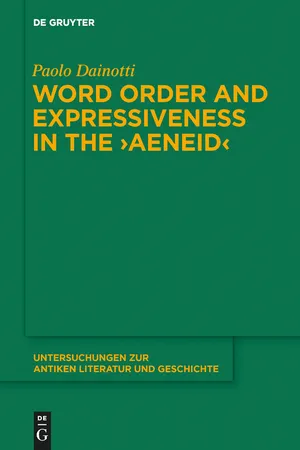![]()
Chapter 1
Poetry and verse
A) Poetry, verse and enjambement in ancient and modern theory
When assessing the expressiveness of a stylistic device in a classical text it is both useful and stimulating to examine modern interpretations, which in many instances can offer fruitful hermeneutic viewpoints. It is, however, methodologically necessary first to analyse classical literary theory and to give due consideration to the obvious differences between Latin poetry, meant essentially for recitation, and modern poetry, in which the typographical aspect also plays a not unimportant role.
Take enjambement. This figure, which, as is well known, arises from the absence of correspondence between syntactical and metrical units, is also indicated in modern poetry by the typographic device of a new line, while in ancient poetry it is perceived only as a rhythmical variation, a breaking of that ‘iterativity’ of equal rhythmical structure which is by definition poetic discourse.64 This marked ‘metricality’, not necessary in modern poetry – to think of free verse – is actually considered the very essence of poetry in many ancient sources.65 Aristotle, in Rhet.3.1408 b 29 ff. advises against the use of verses in prose, because they would turn it into poetry:
ῥυθμὸν δεῖ έχειν τὸν λόγον, μέτρον δὲ μή· ποίημα γὰρ ἔσται.
The verse is also the characteristic feature of poetry for Dionysius of Halicarnassus, who in the last chapter of his De compositione verborum copies a stanza in strophe of Simonides’ Danae, abandoning the strophic division, to show that in the absence of division into metrical cola – in other words, of verses – poetry is no longer poetry and corresponds in every way to pure prose.66 The verse is also the distinguishing characteristic of poetry in numerous other ancient sources, including, for example, Plato, Isocrates and Gorgias.67
These ancient depositions allow us to approach the poetic text with a more conscious view. We cannot really reconstruct the recitation and performance aspects of classical poetry, but some textual evidence provides us with clear indic ations of the means by which the poet marks the end of the verse. This comprises a well-known range of rhythmical factors: the correspondence of arsis and word accent in the final positions of the hexameter;68 the tendency to avoid a long monosyllable + a spondaic word after the caesura at penthemimeral (2½) (Marx’s law);69 or a trochaic caesura contemporaneously in fourth and fifth feet (giving the effect of an anticipated line-ending).70
We must ask, therefore, what the effect of enjambement in ancient poetry is. If the ancient sources lack a specific term for enjambement,71 Dionysius (De Comp. 26.1) describes it clearly, indicating it as a means for bringing poetry closer to prose. The poets, in order to eliminate the regularity and repetitiveness of the metre, and so push us to forget it (εἰς λήθην έμβόλλουσιν ήμáς τοú μέτρου), observes Dionysius, need to ‘cut up’ the verse (διατέμνοντα τό μέτρον), bringing together cola of different lengths (μνισα καὶ όνόμοια) and thereby not matching the phrase to the metrical unit (μ ι συναρπαντίζοντα τοτς στίχοις).72
Although Dionysius’ description does not exhaust all the expressive possibilities of enjambement, it grasps one aspect which will be central to several modern definitions: the effect of ‘breaking’ metrical units in recitation. Tasso, noting enjambement in the sonnets of Della Casa, speaks, not by chance, of ‘rompimenti di versi’ {rupture of verses} and of ‘versi spezzati’ {broken verses};73 In the same way Foscolo observes, also in Della Casa, the ‘verseggiar rotto’ {to write broken verses} and the habit of ‘spezzare la melodia dei versi’ {breaking the melody of the verses}, 74 and indeed from the nineteenth century the term ‘spezzatura’ {breakage} is used to define the device.75
Further definitions highlight, on the other hand, the syntactical aspect. Consider the sixteenth-century definition put forward by Minturno (Arte poetica, p.363), who underscores the idea of syntactical continuity (’catena’ or ‘legamenti di versi’ {sequence or skein of verses}), or the better known and more successful definition of Boileau, who uses the verb enjamber, legal and regulatory in origin (it is used of a beam or rafter which ‘trespasses’ onto the house of a neighbour), to underline, while deploring it, the escape of the phrase into the next line.76
The abundance of terms which scholars of different countries77 have produced over time indicates the uncertainty in identifying with clarity enjambement’s distinguishing characteristics. It seems to have a double nature, or rather is used by a poet to highlight the ‘double shape’78 peculiar to poetic writing, in which two different levels are known to coexist, the syntactical, which answers the need for clarity in communication, and the metrical, which, with its rhythmical limitations, indicates the marks by which poetry may be recognized.
What is important in a discussion on expressiveness is to establish a crit erion for assessing the stylistic importance of a device. Not all enjambements have the same ‘temper’;79 alongside more neutral instances, attributable to the normal articulation of the period, we find others which are intended artistically.80
There is no doubt that the stylistic level of an enjambement depends first on the position of the syntactical pause in the line...
